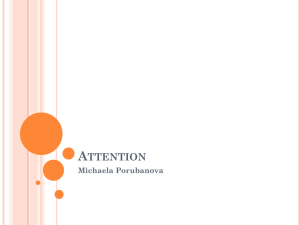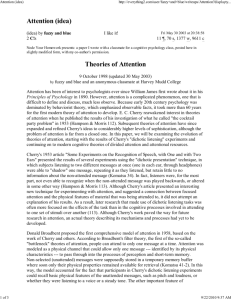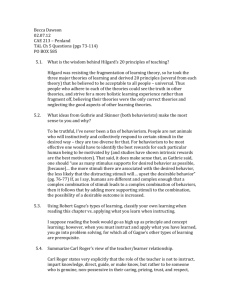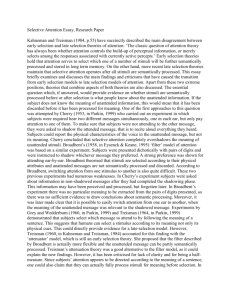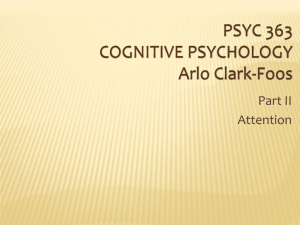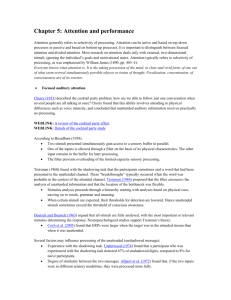Attention - Centre for Neuroscience
advertisement
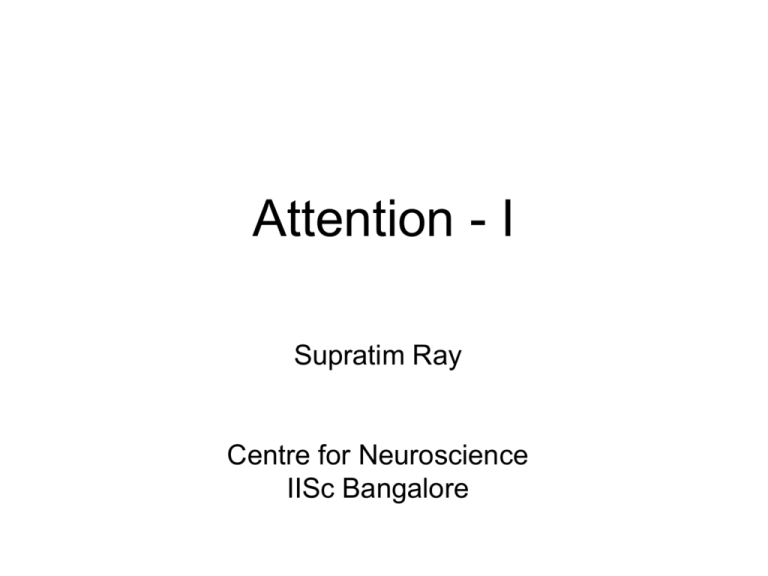
Attention - I
Supratim Ray
Centre for Neuroscience
IISc Bangalore
We don't process everything that we see
Inattention blindness
The failure to notice a fully-visible, but
unexpected object because attention was
engaged on another task, event, or object.
http://www.youtube.com/watch?v=vJG698U2Mvo
Change blindness
The failure to detect changes that are easily seen
once noticed. Such failures can happen even
when the change is large, constantly repeated,
and the observer knows that it occurs.
http://www.cs.ubc.ca/~rensink/flicker/download
Overview of the Lecture
•
Types of Attention
Early Theories of Attention
– Bottleneck Models
– Capacity Models
Feature Integration Theory and Saliency map
Attentional Disorders
– ADHD
– Hemineglect
Types of Attention
A hierarchic model based on the recovering of attention processes
of brain damage patients after coma (Sohlberg and Mateer).
Focused attention: The ability to respond discretely to specific visual,
auditory or tactile stimuli.
Sustained attention (vigilance): The ability to maintain a consistent
behavioral response during continuous and repetitive activity.
Selective attention: The ability to maintain a behavioral or cognitive set in
the face of distracting or competing stimuli. Therefore it incorporates
the notion of "freedom from distractibility."
Alternating attention: The ability of mental flexibility that allows
individuals to shift their focus of attention and move between tasks
having different cognitive requirements.
Divided attention: This is the highest level of attention and it refers to the
ability to respond simultaneously to multiple tasks or multiple task
demands.
Types of Attention – covert and overt
Overt attention is the act of directing
sense organs towards a stimulus
source.
Covert attention is the act of mentally
focusing on one of several possible
sensory stimuli.
Types of Attention: Bottom Up
Types of Attention: Top-down
Bottom up
Stimulus-driven
Exogenous
Automatic
Top Down
Goal-driven
Endogenous
Controlled
Early Theories of Attention
Bottleneck Theories versus Capacity Model Theories
Both are based on the idea that humans have limited information
processing capacity: i.e. we are never able to deal with of all the inputs that
continuously flood into our processing systems from our senses and
memory, and even if we were, we are limited in the number of motor
responses we can make.
Bottleneck theories are a strong version of this limited capacity idea, in that
only one message at a time can enter consciousness, since at some point
processing is reduced to a single channel.
Capacity models, on the other hand, are a weaker version, in that
information can be processed via many channels but that there is a fixed
capacity limit to be distributed amongst the channels.
Theories of Attention
Bottleneck Theories
–
–
–
–
Early Selective Attention, “Filter Theory” (Broadbent ,1958)
Attenuation Theory (Treisman, 1960)
Late-selection Theory (Deutsch and Deutsch,1963)
Pertinence Model (Norman, 1968)
Capacity Theories
– Capacity Theory (Kahneman, 1973)
– Multimodal Theory (Johnson and Heinz, 1978)
Broadbent’s Filter Theory
Experiments were based on “Dichotic Listening Tasks”
http://www.hull.ac.uk/php/edskas/edtech/chapter5.html
Broadbent’s Filter Theory
Incoming stimuli, briefly held in a sensory register, undergo pre-attentive analysis
by a selective filter on the basis of their physical characteristics.
Those stimuli selected pass along a (very) limited capacity channel to a detection
device.
Stimuli not selected ('filtered' out) are not analyzed for meaning and do not reach
consciousness.
Early Selection Theory
“All-or-nothing”
View of perception
http://www.hull.ac.uk/php/edskas/edtech/chapter5.html
Broadbent’s Filter Theory - Issues
Fails to explain the cocktail party effect: Moray (1959) found that although
his subjects could not recall nor recognize irrelevant messages
presented as many as 35 times to the unattended ear, they frequently
heard their own name when presented in this channel
Treisman (1960): If the channels are switched midway in a sentence, we
follow the sentence, not the ear.
Subjects would recall: “sitting at the mahogany table” or “let us look at these three”
Attenuation Theory (Treisman, 1960)
Attention ATTENUATES the strength of some stimuli based on physical
attributes.
A newly proposed element is a ‘dictionary'. This dictionary symbolizes
information, or words, which require a very low threshold in order to be
recognize. Some words (like your name, “danger”, “fire” etc) have a lower
threshold than others.
The stimulus which exceeds the threshold is selected for pattern recognition
Filter versus Attenuation Theory
Broadbent's filter is all-or-nothing (it does not allow
through unattended messages), whereas Treisman's filter
allows unattended messages through, but in an
attenuated form.
Broadbent's is a simple single filter model, whereas
Treisman's can be thought of as a two-stage filtering
process: firstly, filtering on the basis of incoming channel
characteristics, and secondly, filtering by the threshold
settings of the dictionary units.
Both models are “early selection” models, in which
selection occurs prior to pattern recognition.
Attenuation Theory -Issues
More processing of unattended stimuli than allowed by the
model:
Moray (1970) conditioned GSR (Galvanic Skin Response) to
certain words through shock. Presented the word or a
synonym on the unattended channel.
MacKay (1973) shadowed ambiguous passages with
information on the unattended channel that clarified the
ambiguity (ear 1 - bank; ear2 - river or money). Memory test Subjects remembered sentences for which the unshadowed
word gave meaning.
Late selection/Pertinence models
All information is initially processed and selection only takes
place after each input has been analyzed in the memory
system.
Selection for attention is closer to the response (output) than
the sensory end (input).
Information that is more pertinent (relevant/important) is most
likely to be selected.
Information is kept in short term memory and is quickly
forgotten unless it is pertinent.
Unlike the early selection theories, selection occurs AFTER
pattern recognition.
Capacity Theories
Hard to determine the bottleneck, so the
focus is shifted towards the study of
capacity demands
Assumptions
Fixed pool of attentional resources
Resources can be allotted according to task
requirements
Capacity Model (Kahneman, 1973)
• Limit on the capacity to perform mental work.
• Control the allocation of capacity
• Activities compete for attentional resources
• When demand exceeds supply, performance
suffers or fails entirely
• Capacity
– Varies with level of arousal
• Allocation of resources
– Enduring dispositions
• Reflect rules of involuntary
attention
– Momentary intentions
• Reflect specific goals
Capacity Model (Kahneman, 1973)
• Supplements previous bottom-up analysis
with a consideration of top-down influences
• Emphasizes concept of processing
resources
• Attention and mental effort are strongly
correlated
• Arousal can work to increase processing
resources
• Attention is the process of allocating
capacity to various inputs
Attention and Target Selection
P
P
P
P
P
P
P
P
P
P
P
P
P
R
P
P
P
P
P
P
P
P
P
P
P
R
R
R
R
R
R
R
R
R
R
R
R
R
R
R
R
R
R
R
R
R
P
R
R
R
P
P
P
P
P
R
R
R
R
R
Feature Integration Theory (Treisman, 1980)
Distinction between objects and features –
objects are composed of primitive features
Attention used to bind features together
(“glue”) at the attended location
Pre-attentional, parallel processing of
primitive features
Serial processing of feature integration
Feature Integration Theory (Treisman, 1980)
Preattentive Stage: perception of primitives - texture
differences produce “pop-out” boundaries
Feature Integration Theory (Treisman, 1980)
Pre-attentive Stage: perception of primitives - these are
perceived before the object is recognized
Curvature
Tilt (Orientation)
Line ends
Movement
Color
Brightness (Intensity)
Direction of illumination
Example: O's “Pop out” in V's
because they do not share any
primitive features.
A “spotlight” of attention is
used to scan the master
map of locations in search
of a unique object.
Various independent feature
maps are brought into
register with respect to a
master map of locations.
preattentive processors register
the locations of a small set of
primitive visual features on
independent feature maps.
A Saliency map
Itti, L and Koch, C., Nature Reviews Neuroscience, 2001
Saliency Map (Koch and Ullman, 1985)
Different visual features that contribute to attentive selection of a stimulus
(color, orientation, movement etc) are combined into one single
topographically oriented map, the Saliency map, which integrates the
normalized information from the individual feature maps into one global
measure of conspicuity.
Designed as input to the control mechanism for covert selective attention.
Most salient location (in the sense defined above) in a visual scene would
be a good candidate for attentional selection. Once a topographic map
of saliency is established, this location is obtained by computing the
position of the maximum in this map by a Winner-Take-All mechanism.
This role of the saliency map in the control of which locations in the visual
scene are attended is close to that of the "master map" postulated in the
"Feature Integration Theory" proposed by Treisman and Gelade (1980).
http://www.scholarpedia.org/article/Saliency_Map
Once a salient location has been attended, how do
we prevent attention from returning to that location?
After the selection is made, suppression of activity at the selected location leads to
selection of the next location at the location of the second-highest value in the
saliency map.
Suppression is achieved through “inhibition of return”.
http://www.scholarpedia.org/article/Inhibition_of_return
Inhibition of Return (IOR) – Posner and Cohen, 1984
Inhibition of return (IOR) refers to the relative suppression of processing
of (detection of, orienting toward, responding to) stimuli (object and
events) that had recently been the focus of attention.
a) Typical cueing task used to generate and measure inhibition of return (IOR). b)
Results from Posner and Cohen’s (1984) study that first revealed IOR.
http://www.scholarpedia.org/article/Inhibition_of_return
Attentional disorders:
Attention-Deficit/Hyperactivity Disorder (ADHD)
http://www.slideshare.net/Milton.Broome/attention-fundamentals-of-psychology-2-lecture-8
Attention-Deficit/Hyperactivity Disorder (ADHD)
http://www.slideshare.net/Milton.Broome/attention-fundamentals-of-psychology-2-lecture-8
Attentional Disorders – Hemineglect
Hemineglect, also known as unilateral neglect, hemispatial
neglect or spatial neglect, is is a common and disabling
condition following brain damage in which patients fail to
be aware of items to one side of space.
They may eat from only one side of a plate, write on one
side of a page, shave or make-up only the non-neglected
or ipsilesional side of their face (same side as brain
damage).
Classically, the neglect syndrome has been associated with
damage to the right posterior parietal cortex.
http://www.scholarpedia.org/article/Hemineglect
http://www.scholarpedia.org/article/Hemineglect
Neglect is not due to sensory/memory issues
Bisiach and Luzzatti (1978) asked patients with left-sided
visual neglect from Milan to imagine viewing the central
square, the Piazza del Duomo, from the cathedral in the
centre of the square. Next, they asked them to imagine
standing directly in front of the cathedral.
http://www.scholarpedia.org/article/Hemineglec
Unconscious or implicit processing of neglected information
stimuli to the left which were unreported (neglected) by the
patient, nevertheless speeded subsequent responses to a
word if it was semantically related to the neglected item
(e.g., tree and apple) compared to if it was unrelated (e.g.,
bed and apple).
Another study showed a patient pictures of an undamaged
house and one burning with the flames on the left side of
the house (Marshall & Halligan, 1988). When asked which
house they would prefer to live in, a patient with left-sided
neglect, who did not report seeing the flames of the
burning house, nevertheless chose the undamaged house
significantly more often.
